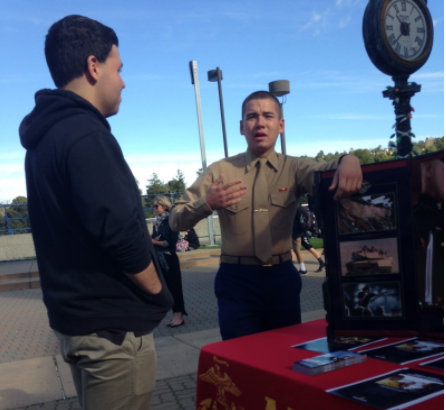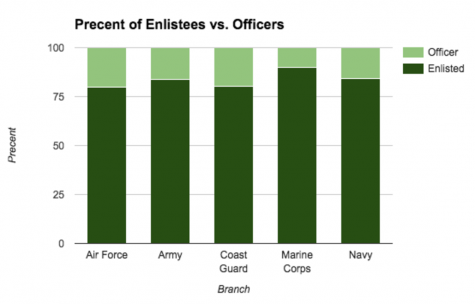
Many Americans each year want to join the military and serve their country. These young Americans face a hard choice, enlist in the military straight out of high school or go to college and train to become an officer.
For most American teenagers, their 18th birthday is a special time in their lives. It is the time when some of them go off to college and some become independent adults. However, some choose instead to join the military either by enlisting straight out of high school, enrolling in a military academy, or going through the Recruit Officer Training Corps (ROTC) program at their college.
Before making these decisions, high schoolers need to know the risks and benefits of each pathway in the Armed Forces.
Many Carlmont students agree that they would likely enlist rather than attend officer’s training to become an officer.
Sophomore Max Jacobs said, “I would probably enlist because I do not want to lead because I would be bad at [leading soldiers].”
Enlistees make up around 83 percent of the armed forces according to a Statistic Brain report of the American military. However, they make up almost 90 percent of combat deaths in the wars in Iraq and Afghanistan according to a cost of war article.
One positive of enlisting is that it is a great way to gain job experience without going to college. Also, enlisting has less pressure than becoming an officer because they have to lead their platoon into combat.
By contrast, an officer’s job is to lead a platoon of 20 to 30 soldiers. They have to be comfortable with making split-second life or death decisions for their platoon. An officer must be comfortable with leading soldiers into combat knowing that every decision could result in killing an enemy or inadvertently killing an ally.
Officers have the same responsibilities as enlisted when it comes to performing combat and noncombat roles. They have many of the same job choices with the exception of taking on a leadership role for whatever they are tasked with. This leadership could be being in charge of the workflow in an office environment or leading the charge into a foreign enemy stronghold.
ROTC is a pathway where future military officers can attend almost any college in the country. The requirements for Army ROTC are to be a U.S. citizen and be between the ages of 17 and 26, have a high school GPA of at least 2.50 and a high school diploma or equivalent, score a minimum of 920 on the SAT or score a 19 on the ACT, meet specified physical standards, and agree to accept a commission and serve in the Army on Active Duty or in a Reserve Component. The other branches of the military have similar ROTC standards.
“I did Army ROTC, they paid for my college. It was a good deal,” said Army Major Bill Arnold, who was in the military during the 1980s.
Besides ROTC, young Americans can become an officer by going to a military academy. There are five such institutions in the United States and are some of the most competitive institutions of higher learning in the United States.
All military academies are tuition free and you get an allowance.
Many of those who serve have positive feedback regarding their decision to join.
Private Dylan Walsh, a Carlmont alumni from the class of 2016 said, “I [would join] a million times over.”
Anyone considering joining any pathway in the military should know what the military is currently involved in overseas. America’s war in Afghanistan is the longest war in America’s history, and it is still going on.
Some people believe the only reason to go in the military is because they cannot get into college. This is not true. For many people, joining the military is important because it pays for their college education or because they believe that it is the right thing to do.
Marine recruiter Staff Sergeant Stella A. Weishaar said, “I [joined the Marines] for the challenge. It is also a way to get out and go see the world and you get a steady income and guaranteed to get paid [twice a month].”
It takes a certain type of person to join the military. It takes courage and a passion for serving America, and a full understanding of the risks and the benefits associated with being involved in the military.











